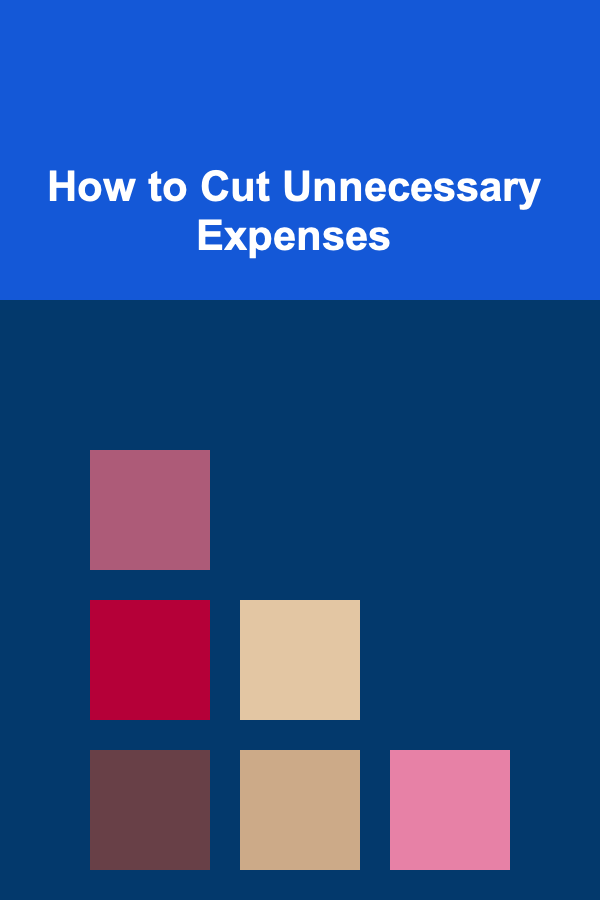
How to Cut Unnecessary Expenses
ebook include PDF & Audio bundle (Micro Guide)
$12.99$5.99
Limited Time Offer! Order within the next:

Managing personal finances effectively is an essential skill for achieving financial freedom and peace of mind. One of the most crucial steps in personal financial management is identifying and cutting unnecessary expenses. It's easy to get caught in a cycle of overspending, but with some intentional effort and strategic planning, you can significantly reduce your monthly expenditures and redirect those funds toward savings or investments. This article delves into how you can cut unnecessary expenses, offering practical advice that will help you improve your financial situation over time.
Understanding Your Financial Habits
The first step in cutting unnecessary expenses is understanding your current financial habits. You cannot address what you do not recognize, so take a moment to assess your spending patterns.
1.1 Track Your Spending
The most effective way to understand your spending habits is to track everything you buy for at least one month. This includes even the smallest purchases---everything from coffee to gas for your car. Use a budgeting app, a spreadsheet, or even pen and paper to record your expenditures.
Tracking your spending helps you identify patterns that you may not have been aware of. You might be shocked at how many small, seemingly insignificant expenses add up over time. Once you have a full picture of where your money is going, you can start looking for areas where you can cut back.
1.2 Categorize Your Expenses
Once you've tracked your expenses, break them down into categories. Common categories include:
- Fixed expenses: These are regular payments that don't change much month-to-month, such as rent/mortgage, utilities, and insurance premiums.
- Variable expenses: These include costs like groceries, entertainment, transportation, and discretionary spending.
- Debt payments: Include credit card payments, loans, and any other outstanding debts.
Categorizing your expenses makes it easier to pinpoint where cuts can be made. Fixed expenses are typically harder to change, but variable expenses provide the most opportunities for cost-cutting.
Eliminate or Reduce Non-Essential Subscriptions
In today's digital age, it's common to accumulate subscriptions without realizing it. Whether it's streaming services, magazine subscriptions, or fitness memberships, these recurring charges can quickly add up.
2.1 Assess Your Subscriptions
Go through all your subscriptions, including streaming platforms, apps, and memberships, and ask yourself whether they are truly necessary. Do you use the service regularly? Can you live without it for a while? Consider whether there are cheaper alternatives that offer similar benefits.
For example, if you're subscribed to multiple streaming services, evaluate how often you actually use each one. You might find that you can cancel some of them, and perhaps rotate between services based on what you're watching. Similarly, look at magazine subscriptions or paid apps---do you really need them, or can you access similar content for free?
2.2 Consolidate or Downgrade Services
If you find that you are paying for multiple services that overlap, try consolidating them into a single service. For example, instead of paying for multiple cloud storage subscriptions, opt for a single, higher-tier plan that covers all your needs.
Similarly, if you're paying for a high-tier subscription that offers more features than you need, consider downgrading to a more affordable version. Many services offer basic plans that provide everything you need at a fraction of the cost.
Reevaluate Your Housing Expenses
Housing is typically the largest expense for most people, but that doesn't mean you have to stay locked into a costly living situation. There are a few ways to reduce housing expenses without sacrificing too much comfort.
3.1 Consider Downsizing
If you're living in a larger home than you truly need, consider downsizing. A smaller home or apartment can reduce your monthly rent or mortgage payments significantly. Downsizing may also lower your utility costs, as smaller spaces are easier to heat and cool.
Before deciding to downsize, assess how much space you truly need. If your current living arrangement is significantly larger than what you require, you could save a substantial amount by moving to a smaller space.
3.2 Refinance Your Mortgage
If you own your home and your mortgage interest rate is high, consider refinancing your loan. Refinancing allows you to secure a lower interest rate, which can reduce your monthly mortgage payments. Even a small reduction in the interest rate can save you hundreds of dollars each month.
Before refinancing, be sure to research different mortgage options and fees involved. You may also want to work with a financial advisor to determine if refinancing is the best choice for your long-term financial goals.
3.3 Negotiate Rent
If you're renting, there might be opportunities to negotiate your rent. This is especially true if you've been in your rental for a while and have a good relationship with your landlord. You might be able to negotiate a lower rent or ask for incentives like a month of free rent in exchange for signing a longer lease.
If rent negotiations aren't an option, consider moving to a less expensive neighborhood or finding a roommate to share costs. Roommates can significantly reduce the cost of rent, utilities, and other living expenses.
Cut Back on Food Costs
Food is another major area where many people overspend without realizing it. Reducing your food expenses is often easier than you might think, and it doesn't have to mean sacrificing the quality of your meals.
4.1 Meal Planning
One of the most effective ways to save on food is by planning your meals ahead of time. Meal planning ensures you only buy what you need and reduces impulse purchases at the grocery store. It also minimizes food waste, as you'll be using everything you buy.
Take some time each week to plan your meals, create a shopping list, and stick to it when you head to the store. Try to buy items in bulk, especially for pantry staples, as this can help lower the cost per unit.
4.2 Cook at Home
Dining out or ordering takeout can be tempting, but it's often much more expensive than cooking at home. Consider preparing simple, cost-effective meals that you can enjoy throughout the week. Cooking in bulk and freezing portions for later can also save both time and money.
Try to experiment with simple recipes that use inexpensive ingredients, such as beans, rice, pasta, and frozen vegetables. These meals can be delicious and nutritious, and they're far less expensive than dining out.
4.3 Avoid Food Waste
Food waste is not only bad for the environment but also bad for your wallet. To avoid throwing away food, make sure to use leftovers, store perishable items correctly, and eat items before they spoil. Organizing your fridge and pantry can also help you keep track of what you have on hand so that you don't forget about items and let them go to waste.
4.4 Bring Your Own Coffee and Snacks
If you're accustomed to buying coffee, snacks, or lunch every day, those small purchases can add up quickly. Consider brewing your own coffee at home and bringing snacks or lunch with you when you leave the house. A few dollars each day might not seem like much, but over the course of a month or year, it can become a significant expense.
Lower Transportation Costs
Transportation expenses, especially for car owners, can be a major financial drain. However, there are a number of ways to lower your transportation costs.
5.1 Use Public Transportation or Carpool
If you live in an area with accessible public transportation, consider using it instead of driving. Public transportation is often much cheaper than owning a car, especially when you factor in gas, maintenance, insurance, and parking costs.
If public transportation isn't an option, consider carpooling with others. Sharing rides with friends or coworkers can reduce your fuel and maintenance costs.
5.2 Sell Your Car or Downsize
If you have a car and are looking to save money, consider whether you really need it. If you can get by without a car, selling it could save you hundreds of dollars per month in car payments, insurance, gas, and maintenance costs.
Alternatively, if you need a vehicle, consider downsizing to a more economical option. Smaller, more fuel-efficient cars typically have lower monthly payments, insurance premiums, and operating costs.
5.3 Shop for Cheaper Insurance
Car insurance is another area where many people overspend. Take the time to shop around and compare quotes from different insurance providers. You might find that you can reduce your monthly premiums without sacrificing coverage. Consider increasing your deductible or removing unnecessary coverage if your car is older or has a low market value.
Embrace Frugality in Everyday Life
Beyond the big-ticket items like housing and transportation, there are many small everyday habits that can add up and increase your expenses. To cut unnecessary costs, embrace a frugal mindset and be mindful of where your money is going.
6.1 Use Coupons and Discounts
Take advantage of coupons, discount codes, and cashback offers whenever you can. Many stores offer discounts for signing up for newsletters, and apps like Honey or Rakuten can help you find online deals.
Before making a purchase, check if there's a discount available, and always look for sales on items you regularly buy. Saving small amounts here and there adds up over time.
6.2 Buy Secondhand or Used Items
For non-essential items like furniture, clothes, or electronics, consider buying secondhand. You can often find high-quality items at a fraction of the price of new ones. Online marketplaces, thrift stores, and garage sales are excellent places to score great deals.
6.3 Limit Impulse Purchases
Impulse purchases are often the result of emotional spending or a lack of planning. To avoid this, create a "cooling-off" period before making purchases. If you see something you want, wait 24 hours (or longer) before buying it. You'll often find that the desire to purchase fades with time, and you'll avoid unnecessary spending.
Automate Your Savings
One of the best ways to ensure that you're cutting unnecessary expenses and saving money is by automating your savings. Set up automatic transfers to a separate savings or investment account each payday. This way, you pay yourself first and ensure that you're putting money aside before you have a chance to spend it.
7.1 Build an Emergency Fund
One of the best ways to avoid unnecessary expenses in the future is by building an emergency fund. Having a safety net of 3-6 months' worth of living expenses can protect you from financial setbacks and prevent you from dipping into credit cards or loans when unexpected expenses arise.
Cutting unnecessary expenses is a gradual process, but it's one that can lead to greater financial security and freedom. By understanding your spending habits, reducing subscriptions, reassessing housing costs, cutting back on food and transportation, and embracing frugality, you can significantly reduce your financial burden. It's about making conscious decisions that align with your long-term financial goals and creating a lifestyle that is more intentional and less dependent on impulse purchases.

How to Build a Family Reunion Committee for Effective Planning
Read More
How to Find Books That Make You Laugh Out Loud
Read More
How to Organize Place Settings for Formal Dinners
Read More
How to Stage a Home for the Winter Season
Read More
How to Live Authentically
Read More
10 Tips for Knitting Baby Blankets: A Checklist for New Knitters
Read MoreOther Products

How to Build a Family Reunion Committee for Effective Planning
Read More
How to Find Books That Make You Laugh Out Loud
Read More
How to Organize Place Settings for Formal Dinners
Read More
How to Stage a Home for the Winter Season
Read More
How to Live Authentically
Read More